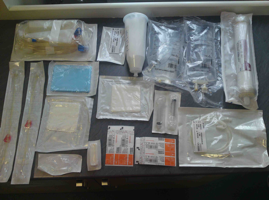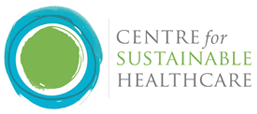- Group home
- You must register/login in order to post into this group.
Waste Management in the Renal Dialysis Unit - Case Study & How-to Guide

By: NHS Greater Glasgow and Clyde
£15,567 (Estimated)
85 tonnes CO2e (Estimated)
Within NHS Greater Glasgow and Clyde (GGC) 505 people attend our chronic hospital haemodialysis programme equating to 78,780 resource intensive treatments per year in six renal dialysis units (RDUs). We targetted clinical waste and unnecessary consumable equipment use as a simple and efficient method of reducing green house gas emissions (GHG) without impacting on the number or quality of dialysis treatments. Our health board already has off-site recycling of nearly 100% it’s domestic waste, so unlike many units we do not need to recycle at source. We focused on diverting wasteaway from expensive incineration and into the domestic waste stream for recycling. Environmental representatives for each of the units were asked to audit current equipment use per dialysis session for both fistula and line users and indentify possible areas of environmental saving in their unit. We then met as a group including senior nursing and medical representatives to agree which changes to make.
Areas of change identified included: Disposal of bicarbonate cartridges into domestic waste, segregation of domestic waste into black bags versus all waste into clinical waste bags as was prior practice, potential for reduction of Griff Bins® and online priming to reduce Saline bags.
Background
The NHS generates 25% of the UK’s public sector GHGs. Legislation now requires drastic cuts in NHS emissions of 80% by 2050. While GHG emissions from procurement including waste, account for 52% of the NHS Scotland total, in renal services, where consumable equipment use is high, this rises to 72% with waste comprising 9.6% and medical equipment 25% of overall emissions. For frequent treatments such as haemodialysis, small environmental and cost savings per treatment can translate into much larger savings overall.
Intended benefits
Benefits to patients:
Dialysis patients are not only more susceptible to climate change (CC) effects such as heat waves and transport disruption, but they rely on the continued supply of drugs and disposable equipment. Reducing GHG emissions now will mitigate the effects of CC and reduce the financial burden associated with renal dialysis allowing redirection of funds into other areas of patient care including the predicted expansion of renal dialysis within our region.
Benefits to staff:
The use of a network of ground level representatives promotes good environmental practice at work and also engages staff in implementing change through quantifying savings directly attributable to their actions.
Benefits to the organisation:
In addition to cost and environmental savings for renal services, this project will contribute to institutional change by promoting lower carbon care on six acute hospital sites. Translating corporate environmental policies into operational practice remains a challenge for the NHS. The approach of using operational level networks of representatives to maintain and promote good environmental practice will generate lasting change and can be adapted to other high resource areas within NHS GGC such as theatres, ITUs and day case procedure areas with large potential savings.
Possible disadvantages
Any potential effects on health and safety, infection control and porter services should be considered and discussed with the relevant departments as needed. No significant problems identified to date, although there is some resistance to getting rid of Griff Bins. Currently this is getting taken up at higher management levels to try and resolve.
What barriers might be encountered when introducing a waste management programme?
All staff contacted were enthusiastic and keen to be able to contribute to reducing GHG emissions. No doubt the challenge will be maintaining good environmental practice in the longer term. The presence of local represenatives in each unit will help to sustain this change together with an ongoing audit process.
Financial Considerations
These changes have been free to implement and have been funded entirely by the good nature and enthusiasm of NHS staff.
Cost and Carbon Savings
Approximately 85 tonnes CO2e and £15,567 annually can be saved across all six RDUs (NOT includine reduced expenditure on unnecessary equipment, such as saline bags). Additionally, five sites use 1.7kg polyethylene Griff Bins® rather than orange clinical waste bags. By reverting to standard clinical waste bags (approximately 14,000 bins saved), 43 tonnes CO2e and £92,832 could be saved annually (£84,000 from purchasing and £8,592 from incineration costs). These estimates do not include supply chain emissions, i.e. those generated from the manufacture and transport of the product to the RDU.
Method of CO2e calculation:
- The CO2e emission conversion factor for the incineration of clinical waste has been taken as 1.8 tonnes CO2e per tonne clinical waste * however higher conversion factors exist. These can double CO2e estimates.
- The CO2e does not include domestic waste figures, which does increase in weight, due to uncertainty surrounding an appropriate conversion factor in our case. NHS GGC has an exemplary domestic waste policy with the majority of waste recycled. So it may represent a net CO2e saving, however further information is required before this calculation can be included.
* Reference: The Carbon Footprint of a Renal Service in the United Kingdom. Connor A, Lillywhite R, Cooke MW. Quarterly Journal of Medicine Advance Access published online on August 18, 2010
Major Risks
Patient Safety
Only non-contaminated waste was diverted into the domestic waste stream so there was no adverse impact on patient safety.
Financial Risks
None identified.
GETTING STARTED – ‘HOW TO’ GUIDE
- Set up the working group:
- Identify waste management representatives from each RDU to promote, sustain and develop an efficient waste management system as part of a coordinated waste management project within NHSGGC renal services.
- Engage senior stakeholders to support the project including senior nursing and medical staff, Renal Services management team, the Education and Practice Development Nurse for Renal Services, the Estates department and the Sustainability Officer for NHS GGC.
- Adapt for your area eg Glasgow already recycles all domestic waste off site, so no need to waste time and money doing this again.
- Focus on “quick wins” to reduce clinical waste by diverting it into the domestic waste stream:
- Use the Green Nephrology Programme as a model of good environmental practice and existing models of a successful waste management eg Queen Margaret Renal Unit, Fife, £36k annually and received 3rd place in the Innovation in Renal Medicine Awards 2011.
- Audit current patterns of consumable equipment use and disposal.
- Identify safe opportunities for reducing clinical waste (uncontaminated material does not need to be incinerated via the clinical waste stream).
- Identify equipment that could be safely removed from the dialysis process.
- Estimate potential financial and GHG emission savings, expressed as carbon dioxide equivalents (CO2e), by weighing clinical and domestic waste from two dialysis sessions (using AV fistula and catheter methods) before and after planned waste reduction and estimating the change in weight overall and emission factor. (Additionally, where unnecessary use of equipment has been discontinued, savings in supply chain emissions may be roughly estimated by multiplying avoided expenditure by the DECC GHG conversion factor* for the medical equipment industry.) *see “The 2009 Guidelines to Defra / DECC's GHG Conversion Factors for Company Reporting, Annex 13
- Consider potential health and safety or infection control issues identified and raise these with these departments as appropriate.
- Implement change and determine the actual cost and environmental savings by auditing total daily waste produced over a period of time before and after waste reduction.
- Repeat the audit after six months to ensure change is maintained.
- Consider extending to inpatient dialysis treatments.
- Look for additional opportunities such as reducing clinical waste for inpatient biopsy or central line procedures.
Further tips
Think of everyone who may be affected by your changes outside your unit eg Hospital Porters if you are changing the type or amount of waste for removal. Talk to these groups first to avoid problems later.
FURTHER INFORMATION & SUPPORT – PLEASE CONTACT:
Pamela Sinclair pamela.sinclair@ggc.scot.nhs.uk
Tara Collidge tara.collidge@nhs.net
Project located across all six renal units in NHS Greater Glasgow and Clyde
Support received via the Green Nephrology Network: http://sustainablehealthcare.org.uk/green-nephrology
